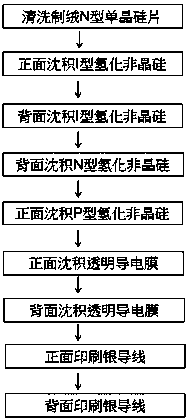High-passivation heterojunction single crystal silicon thin film solar cell
A technology of solar cells and amorphous silicon thin films, applied in circuits, photovoltaic power generation, electrical components, etc., can solve problems such as high energy consumption
- Summary
- Abstract
- Description
- Claims
- Application Information
AI Technical Summary
Problems solved by technology
Method used
Image
Examples
Embodiment Construction
[0004] The structure of the present invention is hereby described as attached figure 1 , detailed below: See figure 2 , is a schematic block diagram of the action flow of the present invention. The process is to first deposit an I-type hydrogenated amorphous silicon film (2) on the front side of the cleaned N-type monocrystalline silicon (1) using plasma-enhanced chemical vapor deposition equipment, and then turn the entire silicon wafer over and place it on the back side. Deposit the I-type hydrogenated amorphous silicon film (2) and the N-type hydrogenated amorphous silicon film (4) in sequence, then turn the entire silicon wafer over and deposit the P-type hydrogenated amorphous silicon film (3) on the front side, Then use magnetron sputtering or reactive physical vapor deposition equipment to deposit a transparent conductive film (5) on the P-type amorphous silicon film (3), and then deposit a transparent conductive film (5) on the N-type amorphous silicon film (4). A t...
PUM
| Property | Measurement | Unit |
|---|---|---|
| Thickness | aaaaa | aaaaa |
| Resistivity | aaaaa | aaaaa |
Abstract
Description
Claims
Application Information
 Login to View More
Login to View More - R&D
- Intellectual Property
- Life Sciences
- Materials
- Tech Scout
- Unparalleled Data Quality
- Higher Quality Content
- 60% Fewer Hallucinations
Browse by: Latest US Patents, China's latest patents, Technical Efficacy Thesaurus, Application Domain, Technology Topic, Popular Technical Reports.
© 2025 PatSnap. All rights reserved.Legal|Privacy policy|Modern Slavery Act Transparency Statement|Sitemap|About US| Contact US: help@patsnap.com


